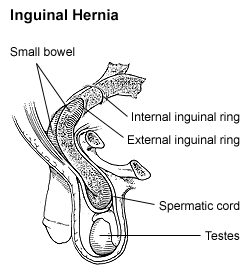A hernia is a condition in which part of the intestine bulges through a weak area in muscles in the abdomen. An inguinal hernia occurs in the groin (the area between the abdomen and thigh). It is called "inguinal" because the intestines push through a weak spot in the inguinal canal, which is a triangle-shaped opening between layers of abdominal muscle near the groin. Obesity, pregnancy, heavy lifting, and straining to pass stool can cause the intestine to push against the inguinal canal.
Symptoms of Inguinal Hernia
 Symptoms of inguinal hernia may include a lump in the groin near the thigh; pain in the groin; and, in severe cases, partial or complete blockage of the intestine. The doctor diagnoses hernia by doing a physical exam and by taking x rays and blood tests to check for blockage in the intestine.
Symptoms of inguinal hernia may include a lump in the groin near the thigh; pain in the groin; and, in severe cases, partial or complete blockage of the intestine. The doctor diagnoses hernia by doing a physical exam and by taking x rays and blood tests to check for blockage in the intestine.
Treatment
The main treatment for inguinal hernia is surgery to repair the opening in the muscle wall. This surgery is called herniorrhaphy. Sometimes the weak area is reinforced with steel mesh or wire. This operation is called hernioplasty. If the protruding intestine becomes twisted or traps stool, part of the intestine might need to be removed. This surgery is called bowel resection. (Bowel is another word for intestine.)
Resources:
National Digestive Diseases Information Clearinghouse. Gastroparesis and Diabetes. National Institute of Diabetes and Digestive and Kidney Diseases. National Institutes of Health. NIH Publication No. 02–4634, January 2002.
Image Credit: National Digestive Diseases Information Clearinghouse. National Institute of Diabetes and Digestive and Kidney Diseases. National Institutes of Health. NIH Publication No. 00-2750,February 2000.
Page Last Reviewed: February 7, 2011
Symptoms of Inguinal Hernia
 Symptoms of inguinal hernia may include a lump in the groin near the thigh; pain in the groin; and, in severe cases, partial or complete blockage of the intestine. The doctor diagnoses hernia by doing a physical exam and by taking x rays and blood tests to check for blockage in the intestine.
Symptoms of inguinal hernia may include a lump in the groin near the thigh; pain in the groin; and, in severe cases, partial or complete blockage of the intestine. The doctor diagnoses hernia by doing a physical exam and by taking x rays and blood tests to check for blockage in the intestine.Treatment
The main treatment for inguinal hernia is surgery to repair the opening in the muscle wall. This surgery is called herniorrhaphy. Sometimes the weak area is reinforced with steel mesh or wire. This operation is called hernioplasty. If the protruding intestine becomes twisted or traps stool, part of the intestine might need to be removed. This surgery is called bowel resection. (Bowel is another word for intestine.)
Resources:
National Digestive Diseases Information Clearinghouse. Gastroparesis and Diabetes. National Institute of Diabetes and Digestive and Kidney Diseases. National Institutes of Health. NIH Publication No. 02–4634, January 2002.
Image Credit: National Digestive Diseases Information Clearinghouse. National Institute of Diabetes and Digestive and Kidney Diseases. National Institutes of Health. NIH Publication No. 00-2750,February 2000.
Page Last Reviewed: February 7, 2011
